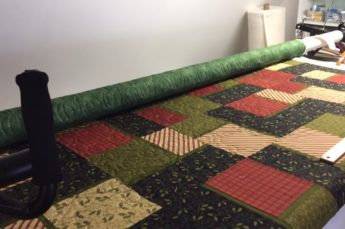Quilt Top :
 It is important to apply your borders squarely.
It is important to apply your borders squarely.
If the borders are longer than the top, then the top will not lay flat. Pleats and puckers may develop during the quilting process.
To apply borders:
-
Measure your pieced top (before the borders are added). Lay your top out on a flat surface and measure at least three different places across the width and length.
-
If these measurements are not equal, calculate the average measurement and use this result to cut the borders.
-
Apply the border to the quilt top evenly. Using an even feed foot can be helpful.
-
Fullness and/or puckers within a border cannot be quilted out. I’ll try my best to work in some fullness, but cannot guarantee that puckers and tucks will not be sewn in. Just remember, the flatter your quilt top lays, the better your finished quilt will look.
-
Please make sure all your seams are secure and your threads are clipped. Unclipped threads can show through lighter fabrics.
-
Press seam allowances to leave the least bulk at the seams.
-
Press your quilt top.
-
If the quilt is directional please mark the top edge of your quilt top with a safety pin.
-
Please do not layer top, batting and backing. They are loaded on the quilting machine as separate layers.
Quilt Back:
-
Leave the selvage edges on outer edges of the quilt backing.
-
After stitching the seams of the backing cut off any selvage edges along the seam line, use at least a 1/2″ seam allowance. Removing the selvage in the seam will keep the seam from puckering when washed.
-
Size of the back: must be at least 4″ wider on each side, top and bottom, than your quilt top.
-
Trim the top and bottom edges of your backing so they are straight and square. This ensures the quilt loads onto the machine straight; this is important for keeping the design square on your top.
-
If the back fabric is a directional print please mark the top edge of your quilt back with a safety pin.